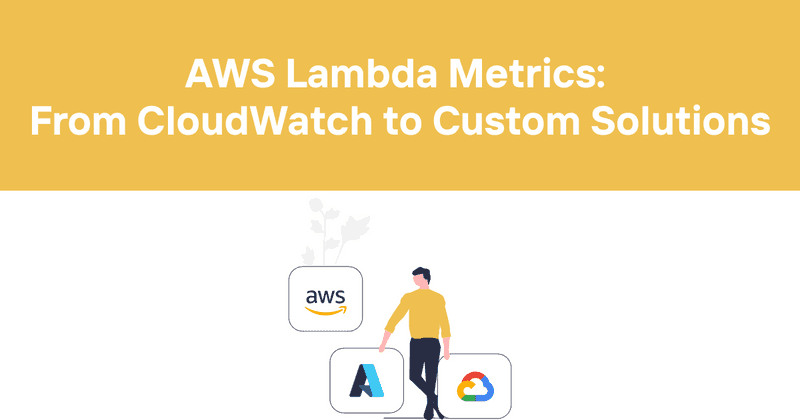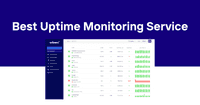AWS Lambda Metrics: From CloudWatch to Custom Solutions
Monitoring AWS Lambda functions effectively can be the difference between a serverless application that thrives and one that falls flat. I've spent years working with Lambda, and trust me, without proper metrics, you're essentially flying blind. Whether you're debugging performance issues or trying to optimize costs, Lambda metrics are your compass in the serverless wilderness.
Table of Contents
- Introduction to AWS Lambda Metrics
- Core Lambda Metrics You Need to Track
- CloudWatch Integration for Lambda Monitoring
- Custom Metrics for Advanced Monitoring
- Cold Starts: Measuring and Mitigating
- Cost Optimization Through Metrics
- Performance Tuning with Lambda Metrics
- Setting Up Effective Alarms
- Monitoring Lambda in Production
- Third-Party Monitoring Solutions
- Visualizing Lambda Metrics
- Metrics for Lambda-based APIs
- Troubleshooting Common Issues
- Best Practices for Lambda Monitoring
- Conclusion
Introduction to AWS Lambda Metrics
AWS Lambda has transformed how we build and deploy applications, eliminating the need to manage servers while providing auto-scaling capabilities. But this convenience comes with a trade-off: the need for specialized monitoring approaches.
Let's face it—serverless doesn't mean worry-free. When your functions aren't behaving as expected, you need visibility into what's happening behind the scenes. That's where Lambda metrics come in.
Lambda metrics provide quantitative measurements of your function's behavior, performance, and resource consumption. They answer critical questions like:
- Is my function executing successfully?
- How long are executions taking?
- Am I approaching resource limits?
- Are my functions cost-efficient?
Without these insights, troubleshooting becomes guesswork, and optimization becomes impossible. I remember working on a project where we were scratching our heads over inconsistent performance until we properly set up monitoring—turns out our function was constantly hitting memory limits during peak loads, something we wouldn't have identified without the right metrics.
Core Lambda Metrics You Need to Track
AWS automatically generates several metrics for your Lambda functions. These are the foundation of any monitoring strategy:
Invocation Metrics:
- Invocations: The number of times your function code is executed
- Errors: The number of invocations that failed due to errors in your function
- Throttles: The number of invocation requests that were throttled
- DeadLetter Errors: Errors that occurred when sending events to a dead-letter queue
- Destination Delivery Failures: Failed deliveries to destinations
Performance Metrics:
- Duration: The time your code spends running (billed duration)
- Iterator Age: For stream-based invocations, the age of the last record processed
- Concurrent Executions: The number of function instances running simultaneously
- Provisioned Concurrency Spillover Invocations: Invocations that spilled over provisioned concurrency
Here's a breakdown of the most critical Lambda metrics in table format:
| Metric Name | Description | Why It Matters | Typical Threshold |
|---|---|---|---|
| Invocations | Count of function executions | Tracks usage patterns | Depends on expected load |
| Errors | Failed executions | Indicates code issues | <1% of invocations |
| Duration | Execution time in ms | Affects cost and performance | Function-dependent |
| Throttles | Rejected executions | Shows concurrency limits | Should be near zero |
| ConcurrentExecutions | Simultaneous function instances | Resource utilization | Below account limit |
| Memory Utilization | % of allocated memory used | Right-sizing opportunity | 60-80% ideal |
What's interesting about these metrics is they tell different parts of the same story. Duration might look fine on average, but if you examine the p90 or p99 percentiles, you might find outliers that are causing sporadic issues for your users.
CloudWatch Integration for Lambda Monitoring
Amazon CloudWatch is tightly integrated with Lambda, automatically collecting all the core metrics mentioned above. This integration is free and requires no setup, making it the first line of defense in your monitoring strategy.
Lambda metrics appear in CloudWatch under the "AWS/Lambda" namespace. You can view them through:
- CloudWatch console
- AWS CLI
- AWS SDKs
- CloudWatch API
The real power comes from creating custom dashboards that combine multiple metrics. For example, I like to create dashboards that show invocations, errors, and duration on the same graph, making it easy to spot correlations between spikes in traffic and degradation in performance.
Here's a quick CLI command to get your Lambda metrics:
--metric-name Duration
--statistics Average
--period 3600
--start-time 2025-01-01 T00:00:00Z
--end-time 2025-01-02 T00:00:00Z
--dimensions Name=FunctionName, Value= YOUR_FUNCTION_NAME
CloudWatch retains Lambda metrics for 15 months, allowing for long-term trend analysis. But there's a catch—the default resolution is 1 minute, which might not be sufficient for detecting short-lived issues. For higher resolution, you'll need to explore custom metrics.
Custom Metrics for Advanced Monitoring
While the built-in metrics are useful, they often don't tell the whole story. Custom metrics let you track business-specific data points that matter to your application.
To create custom metrics, you can:
- Use the CloudWatch API directly from your Lambda function
- Log structured data and extract metrics using CloudWatch Logs Insights
- Use the Embedded Metric Format for high-cardinality metrics
Here's a simple example of sending a custom metric from a Lambda function:
const cloudwatch = new AWS.CloudWatch ();
exports.handler = async (event) => {
// Send custom metric
await cloudwatch. putMetricData({
MetricData: [{
Value: processingTime,
Unit: 'Milliseconds',
Dimensions: [
{ Name: 'Environment', Value: process.env. ENVIRONMENT }
return result;
Some custom metrics I've found particularly valuable include:
- Business transaction success rates
- Dependency response times
- Cache hit/miss ratios
- Payload sizes
- Customer-specific usage patterns
But be careful! Custom metrics cost money, and sending too many can increase your CloudWatch bill significantly. Focus on metrics that actually drive decisions.
Cold Starts: Measuring and Mitigating
Cold starts are one of the most notorious aspects of Lambda functions. They occur when a new instance of your function is initialized, causing a delay in response time.
To measure cold starts, you can:
- Use X-Ray tracing to see initialization time
- Log timestamps at the beginning and end of the initialization code
- Track the "Init Duration" metric available in CloudWatch Logs
Cold starts are particularly problematic for:
- Functions with large dependencies
- Functions using the Java or .NET runtimes
- Functions inside VPCs
- Functions that rarely execute
Here's what a cold start looks like in CloudWatch Logs:
Duration: 12.34 ms
Billed Duration: 100 ms
Memory Size: 128 MB
Max Memory Used: 18 MB
Init Duration: 287.53 ms
That "Init Duration" is the cold start penalty you're paying.
Mitigation strategies include:
- Using Provisioned Concurrency
- Implementing pre-warming techniques
- Optimizing package size
- Choosing lightweight runtimes (Node.js or Python)
- Moving initialization code outside the handler
I've seen cold starts reduced from several seconds to under 100ms by simply restructuring code and optimizing dependencies. The improvements to user experience can be dramatic.
Cost Optimization Through Metrics
Lambda billing is based on two factors: the number of requests and the duration of execution. By monitoring the right metrics, you can optimize both.
Metrics that directly impact cost include:
- Duration: Directly affects your bill
- Memory configuration: Affects both price per ms and performance
- Invocations: Each request incurs a charge
- Error rate: Failed executions still cost money
One powerful cost optimization technique is right-sizing your Lambda functions. By analyzing the "Max Memory Used" metric (available in CloudWatch Logs), you can determine if your function has too much allocated memory.
For example, if your function consistently uses only 128MB of its allocated 512MB, you're potentially paying 4x more than necessary. Conversely, if memory utilization is consistently near 100%, increasing allocation might improve performance and reduce overall duration costs.
A cost optimization dashboard should include:
- Cost per function
- Cost trends over time
- Memory utilization versus allocation
- Duration distribution (to identify outliers)
I once reduced a client's Lambda bill by 40% just by implementing proper memory allocation based on metrics analysis. The functions actually ran faster and cost less—a rare win-win in engineering.
Performance Tuning with Lambda Metrics
Performance optimization starts with establishing baselines. What's "normal" for your function? Only by understanding typical behavior can you identify and address abnormal patterns.
Key performance metrics to track include:
- Average, p50, p90, and p99 duration
- Memory utilization
- Execution concurrency
- Dependency response times (custom metrics)
Performance tuning steps based on metrics:
- Identify bottlenecks: Look for consistent patterns in high-duration invocations
- Profile memory usage: Memory and CPU are linked in Lambda—more memory means more CPU
- Track external dependencies: Often the biggest performance factor is outside your function
- Monitor cold starts: They can skew overall performance metrics
Let me share a real-world example: A function that processed images was taking 6 seconds on average. Metrics showed memory usage spiking to near the limit. By increasing memory allocation from 512MB to 1GB, average duration dropped to 2.5 seconds. This actually reduced costs despite the higher memory price because the overall duration decreased significantly.
Performance tuning isn't a one-time activity. Set up automated alerts for performance degradation and regularly review metrics to catch issues before they impact users.
Setting Up Effective Alarms
Alarms convert passive monitoring into active notification. CloudWatch alarms let you trigger actions when metrics cross predefined thresholds.
Essential Lambda alarms include:
- Error rate: Alert when errors exceed normal levels
- Throttling: Any throttling usually indicates a configuration issue
- Duration p99: Catch performance degradation affecting a subset of users
- Concurrent executions: Alert when approaching account limits
- Iterator age: For stream-based functions, alert on processing backlogs
When setting alarm thresholds, consider:
- Historical patterns (what's normal for your function?)
- Business impact of the metric
- Time of day (some functions have expected usage patterns)
Here's an example of setting up an error rate alarm using CloudFormation:
Properties:
AlarmDescription: Alert on high error rate
Namespace: AWS/Lambda
MetricName: Errors
Dimensions:
Value: !Ref FunctionName
Period: 60
EvaluationPeriods: 5
Threshold: 5
ComparisonOperator: GreaterThan Threshold
TreatMissingData: notBreaching
AlarmActions:
Beyond just setting alarms, establish clear response procedures. Who gets notified? What steps should they take? Document this in your incident response playbook.
Monitoring Lambda in Production
Production environments require more sophisticated monitoring approaches than development. In production, you need:
- Real-time monitoring: Quick detection of issues
- Historical analysis: Understanding trends and patterns
- Correlation: Connecting Lambda metrics with other services
- Business impact assessment: Translating technical metrics to business outcomes
A comprehensive production monitoring strategy includes:
-
Multi-level dashboards:
- Executive view (service health)
- Operational view (technical metrics)
- Debugging view (detailed function metrics)
-
Proactive alerting:
- Warning alerts for approaching thresholds
- Critical alerts for immediate action items
- Automated remediation where possible
-
Log analysis:
- Structured logging
- Log correlation using request IDs
- Log-based metrics extraction
-
Distributed tracing:
- End-to-end request visualization
- Dependency mapping
- Bottleneck identification
CloudWatch Logs Insights is particularly useful for production monitoring. It allows SQL-like queries across your logs, helping identify patterns that might not be apparent in individual log entries.
For example, to find the slowest Lambda invocations:
| parse @message /Duration: (?<duration>.*?) ms/
| sort duration desc
| limit 10
This kind of ad-hoc analysis is invaluable when troubleshooting production issues.
Third-Party Monitoring Solutions
While CloudWatch provides basic monitoring capabilities, many teams augment it with third-party solutions for advanced features. These tools often provide:
- More intuitive dashboards
- Advanced alerting capabilities
- Better correlation between services
- Specialized serverless insights
- Profiling and debugging tools
Popular third-party monitoring solutions for Lambda include:
- Datadog
- New Relic
- Epsagon
- Lumigo
- Thundra
- Dynatrace
- Sentry
These tools typically work by:
- Instrumenting your code with a lightweight agent
- Collecting telemetry data during execution
- Sending this data to their platform for analysis
- Providing specialized dashboards and alerts
Here's a comparison of key features:
| Feature | CloudWatch | Third-Party Tools |
|---|---|---|
| Setup complexity | Low (built-in) | Medium (requires instrumentation) |
| Cost | Pay for custom metrics | Subscription-based |
| Visualization | Basic | Advanced |
| Alerting | Basic | Sophisticated |
| Distributed tracing | Requires X-Ray | Often built-in |
| Retention | 15 months | Varies by provider |
| Lambda-specific insights | Limited | Extensive |
I've used both approaches over the years, and the right choice depends on your scale, complexity, and budget. For smaller applications, CloudWatch might be sufficient. For complex, mission-critical applications, third-party tools often pay for themselves through faster troubleshooting and better insights.
Visualizing Lambda Metrics
Data visualization transforms raw metrics into actionable insights. Effective dashboards make patterns immediately apparent and help identify issues before they become critical.
When designing Lambda dashboards, consider these visualization types:
- Line charts: Perfect for time-series data like invocations or duration
- Heatmaps: Great for visualizing distribution (like duration percentiles)
- Gauges: Useful for utilization metrics against limits
- Tables: Good for detailed metric breakdowns
- Single value displays: For key performance indicators
A well-designed dashboard should tell a story at a glance. Group related metrics together and organize from high-level to detailed information.
For example, a comprehensive Lambda dashboard might include:
-
Service Health Panel:
- Success rate
- Error count
- Throttle count
- P99 duration
-
Usage Panel:
- Invocations over time
- Concurrent executions
- Duration distribution
- Cost metrics
-
Function-Specific Panels:
- Detailed metrics for critical functions
- Custom business metrics
- Dependency performance
CloudWatch Dashboards let you combine these visualizations, but they have limitations in terms of interactivity and advanced visualizations. This is another area where third-party tools often excel.
Metrics for Lambda-based APIs
Lambda functions powering APIs have specialized monitoring needs beyond standard metrics. These functions act as the interface between your users and your system, making their performance especially critical.
For Lambda-based APIs, track these additional metrics:
- End-to-end latency: Full request lifecycle time
- Integration latency: Time spent outside the Lambda function
- HTTP status code distribution: Pattern of 2xx, 4xx, and 5xx responses
- Cache hit rate: For API Gateway cache
- Request count by resource/method: Usage patterns across endpoints
API Gateway provides many of these metrics in the "AWS/ApiGateway" namespace, which you can correlate with Lambda metrics.
A common pattern I've seen is creating a combined dashboard that shows the full request flow:
- API Gateway request received
- Lambda function invoked
- Lambda connects to dependencies (database, other services)
- Response returned to user
This end-to-end visibility is crucial for understanding the true user experience.
For REST APIs built with API Gateway and Lambda, consider these monitoring strategies:
- Track metrics at each integration point
- Set up separate alarms for API Gateway and Lambda
- Implement client-side monitoring to capture the true user experience
- Use X-Ray tracing to visualize the full request path
Troubleshooting Common Issues
When things go wrong with Lambda functions, metrics are your first diagnostic tool. Here are common Lambda issues and the metrics that help identify them:
1. Function Timeouts
- Symptom: Duration metrics approaching the configured timeout
- Investigation: Check for slow dependencies or inefficient code
- Metrics to check: Duration (especially p90 and p99), custom dependency metrics
2. Memory-Related Failures
- Symptom: Out of memory errors in logs, functions terminating unexpectedly
- Investigation: Check memory utilization and optimize code
- Metrics to check: Memory used (from logs), duration spikes
3. Throttling Issues
- Symptom: Throttles metric increasing, failed invocations
- Investigation: Review concurrency limits and usage patterns
- Metrics to check: Throttles, ConcurrentExecutions, invocation patterns
4. Cold Start Problems
- Symptom: Occasional high latency, especially after idle periods
- Investigation: Optimize initialization, consider provisioned concurrency
- Metrics to check: Duration percentiles, Init Duration from logs
5. Integration Failures
- Symptom: High error rates, timeout patterns
- Investigation: Check dependent services and networking configuration
- Metrics to check: Error metrics, custom dependency metrics, X-Ray traces
When troubleshooting, correlation is key. For example, a spike in errors might coincide with a deployment, a traffic surge, or an issue with a dependency. Looking at multiple metrics together often reveals the true cause faster than examining each in isolation.
Best Practices for Lambda Monitoring
Based on years of working with Lambda in production, here are my top monitoring best practices:
-
Monitor at multiple levels
- Individual function health
- Service-level metrics
- Business impact metrics
-
Implement structured logging
- Use consistent JSON format
- Include request IDs for correlation
- Log contextual information (not just errors)
-
Set meaningful alerts
- Alert on symptoms, not causes
- Establish baseline before setting thresholds
- Avoid alert fatigue with proper tuning
-
Design for observability
- Emit custom metrics for business logic
- Use correlation IDs across services
- Instrument critical code paths
-
Automate routine analysis
- Regular cost optimization reviews
- Performance trend analysis
- Capacity planning based on growth patterns
-
Document monitoring procedures
- Runbooks for common alerts
- Escalation paths
- Troubleshooting guides
-
Review and improve
- Conduct post-incident reviews
- Identify monitoring gaps
- Continuously refine metrics and alerts
These practices evolve as your application matures. What works for a new application might not be sufficient as it scales. Regularly review your monitoring strategy to ensure it continues to meet your needs.
Conclusion
Effective Lambda metrics monitoring is not just about collecting data—it's about generating actionable insights that improve reliability, performance, and cost-efficiency. The serverless nature of Lambda requires a shift in monitoring approach from traditional server-based applications, focusing more on execution patterns, performance distributions, and integration points.
By implementing a comprehensive monitoring strategy that includes both standard and custom metrics, setting up appropriate alerts, and regularly analyzing performance patterns, you can ensure your Lambda functions operate reliably and efficiently.
For teams looking to improve their Lambda monitoring capabilities, Odown provides a comprehensive solution that goes beyond basic metrics. With features like detailed uptime monitoring, SSL certificate tracking, and public status pages, Odown helps ensure your Lambda-based applications remain reliable and performant. The platform's seamless integration with AWS services makes it an excellent complement to native CloudWatch capabilities, providing enhanced visibility and alerting options for mission-critical serverless applications.
Remember that monitoring is not a set-it-and-forget-it activity. As your application evolves, so should your monitoring strategy. Continuously refine your metrics, dashboards, and alerts to match your current needs and challenges.
By making Lambda metrics a priority, you're not just avoiding problems—you're building the foundation for a high-performing, cost-efficient serverless architecture that can scale with confidence.



